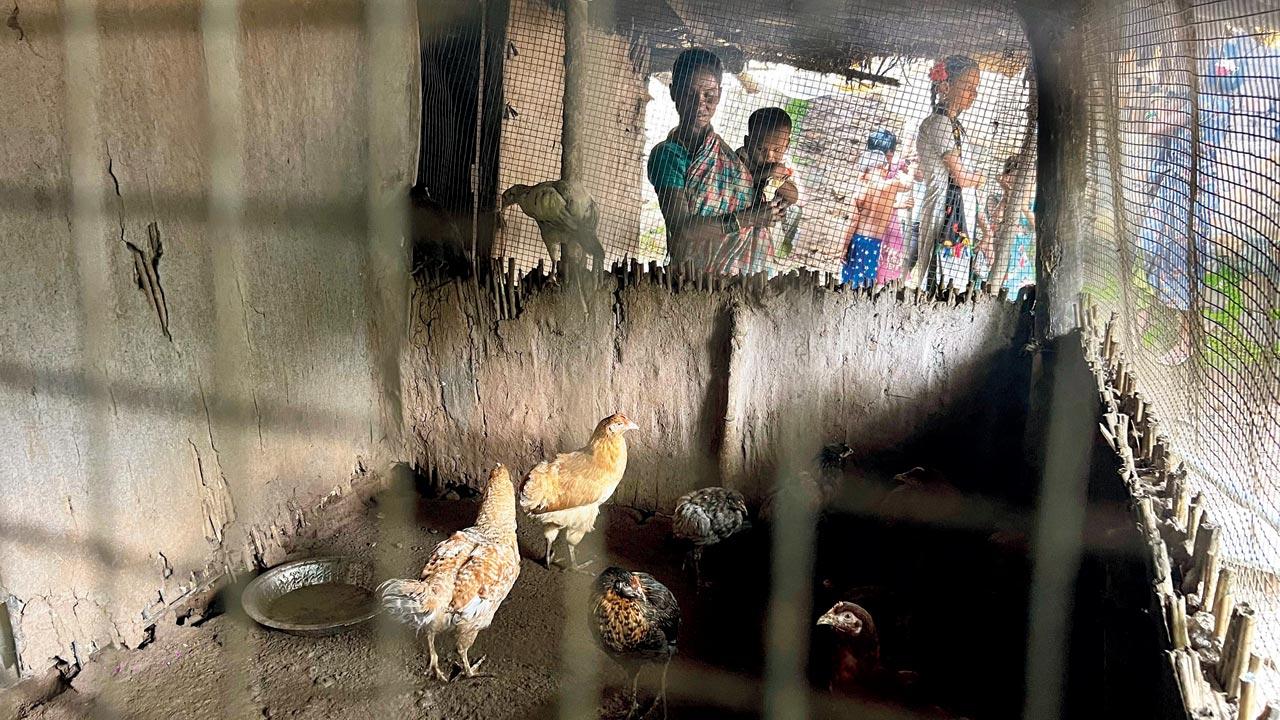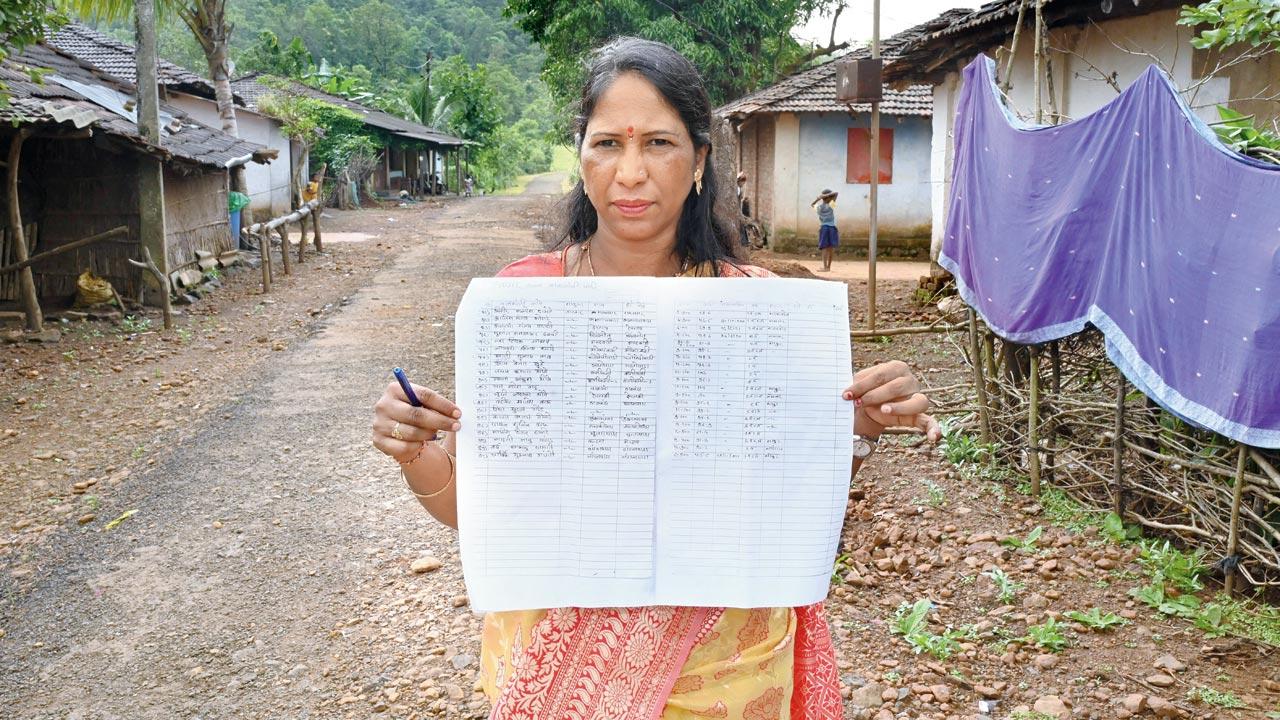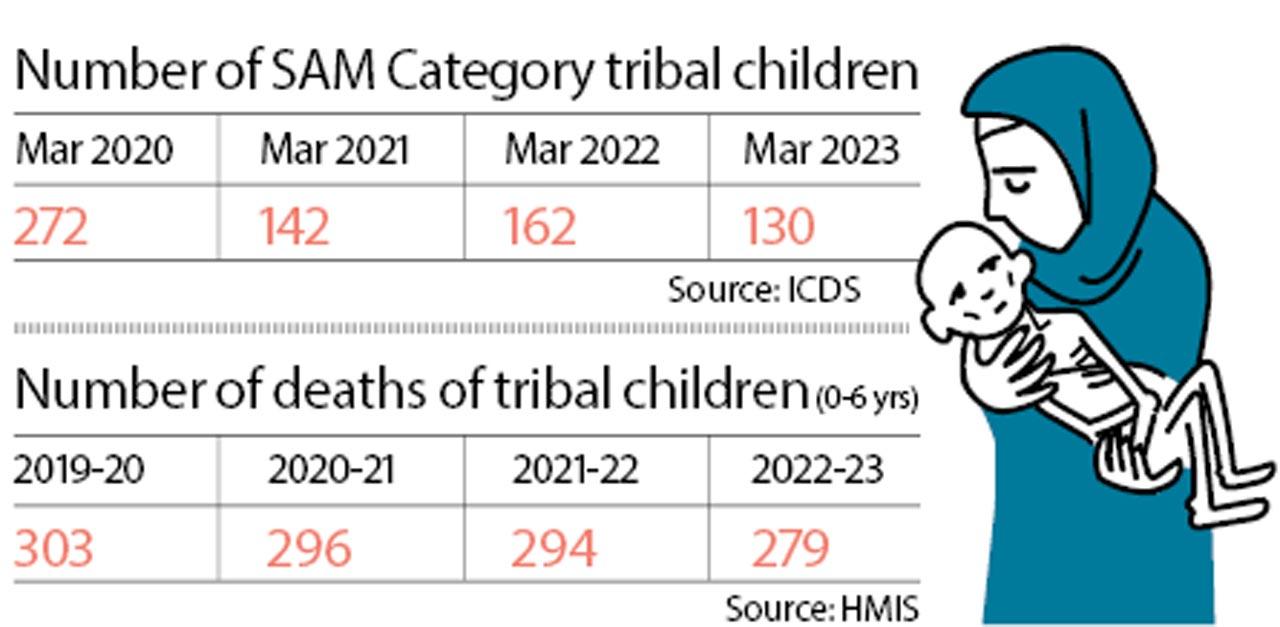The latest government data pegs kids with severe malnutrition and highest risk of death at 166; 32 have already died this year in Jawhar alone. Why are residents struggling to feed their children and livestock despite generous free grain schemes?

One-and-a-half-year-old Vidya Jayaram Koti, who has been admitted to the Nutrition Rehabilitation Centre in Mokhada taluka, is currently critical. She weighs 4.5 kg, when her ideal weight should have been over 10 kg. Eight-month-old Sarthak Salkar, who weighs 4.5 kg, came to centre with his mum Sangeeta on August 23. “But it’s been over 10 days, and he has only gained 0.1 kg,” his mum shared. Pics/Hanif Patel
The tiny, 20-bed Nutrition Rehabilitation Centre (NRC) in the Mokhada taluka of Palghar is crammed with children and their young mothers. The yellow walls are adorned with attractive drawings—a towering giraffe and young fawn reminiscent of Disney’s Bambi are seen looking either way; there are also paintings of “dancing” greens—broccoli, bottle gourd and capsicums—carrots, tomato, brinjal and pumpkin. In another artwork, five children are seen flaunting vegetable masks. Everything is meant to focus on healthy eating and nutritious food. But the 11 children at the centre might barely be able to identify with the messaging—they have probably never even eaten
these veggies.
ADVERTISEMENT
The children, all between ages one and five, have been admitted to the centre, because they are malnourished.
One-and-a-half-year-old Vidya Jayaram Koti is currently critical. She weighs 4.5 kg and is 62.3 cm-tall. As per the World Health Organisation, the median weight of an 18-month-old should be 10.2 kg. She was admitted following a screening at her village. “We asked her parents to admit her to the NRC as she fell under the severe acute malnutrition (SAM) category,” shares Sita Ghatal, in-charge of Shree Vithu Mauli Charitable Trust, Bal Sanjiv and Chhavani, a Palghar-based NGO. Koti was brought to the hospital a week ago, and she still has a long road to recovery.
 The state-run Nutrition Rehabilitation Centre (NRC) in the Mokhada taluka of Palghar, currently has 11 children along with their caregivers
The state-run Nutrition Rehabilitation Centre (NRC) in the Mokhada taluka of Palghar, currently has 11 children along with their caregivers
Eight-month-old Sarthak Salkar’s mother Sangeeta is worried about her son’s deteriorating health condition. “When I brought him to the NRC on August 23, he was 4.5 kg. But it’s been over 10 days, and he has only gained 0.1 kg. He is not very active either,” she tells this writer. The other children at the centre look drained and tired. They aren’t interested in playing with the toys in the centre, and prefer lying down on the bed for most part of the day.
Undernourished children, especially those diagnosed with SAM, usually do not have an appetite for food. “And if they are forced to eat anything, they might throw up or face an irritable stomach,” a doctor at the NRC shares. It is for this very reason that doctors at NRC first provide them formula. The children are given F75 (75 kcal/100mL) diet during the initial phase of treatment and F100 (100kcal/100mL) after their appetite has returned. “This diet includes therapeutic foods/milk that contain added vegetable fat, carbohydrates, vitamins and minerals,” the doctor says. “Once they start eating, we provide them egg, banana, rice, and sweet dishes with jaggery,” says the doctor. Salt is a strict no-no.
The undernourished children are kept at the centre for 14 days. Their weight is measured daily. “If the recovery rate is slow, we extend their stay for 21 days,” the doctor adds.
 Nandgaon villager Kamal Lokhande’s two-year-old son Vinay has been diagnosed with severe acute malnutrition. She doesn’t get enough rations to feed either her children or her poultry. “We are all starving,” she says
Nandgaon villager Kamal Lokhande’s two-year-old son Vinay has been diagnosed with severe acute malnutrition. She doesn’t get enough rations to feed either her children or her poultry. “We are all starving,” she says
Regular monitoring of Palghar’s tribal children is the only way forward to tackle the ongoing malnourishment problem in the region, feels Ghatal.
According to the recent Health Management Information System (HMIS) data, a total of 90 tribal children died this year till July. The worst-hit taluka was Jawhar, where 32 tribal children succumbed to malnutrition.
Palghar’s Village Child Development Centre (VCDC) has identified 166 tribal children who fall under the SAM category and are “facing growth retardation and impaired psychological, as well as cognitive development”. “Meanwhile, 1,585 children have Moderate Acute Malnutrition (MAM),” shares a medical officer in the district. “Children who come under the SAM category are at a higher risk of dying. They need immediate medical attention, balanced diet, proper care and affection,” says another medical officer at the district.
 Nisha Sapta with her son Tanish Sapta, who has a congenital limb defect. While he has been diagnosed with severe acute malnutrition, his parents weren’t aware of this, until a local NGO pointed it out
Nisha Sapta with her son Tanish Sapta, who has a congenital limb defect. While he has been diagnosed with severe acute malnutrition, his parents weren’t aware of this, until a local NGO pointed it out
Experts feel that inadequate supply of ration to the poor in Palghar, under the Antyodaya Anna Yojana (AAY), has led to the current crisis.
The Government of India had launched the AAY scheme on December 25, 2000, to provide highly subsidised food to millions of the poorest families. The scheme was first implemented in Rajasthan, before it was adopted by other states.
“Most of the poor tribal population in Palghar is eligible to get ration under AAY, but the state government is yet to implement this scheme correctly,” says Ghatal.
To avail subsidised ration under AAY, the government has made it mandatory for every beneficiary to link their Aadhar to their ration card. “But at these remote villages, there is no internet facility. Local residents are often seen running from one spot to another to get good mobile network. How will they link their Aadhar cards?” asks Ghatal.
 Sita Ghatal, in-charge of the Palghar-based NGO Shree Vithu Mauli Charitable Trust, Bal Sanjiv and Chhavani, has been conducting periodic screenings of tribal children in the villages of Palghar. Her team has identified several children in Jawhar, Mokhada, Wada and Vikramgarh, who are currently battling for their lives
Sita Ghatal, in-charge of the Palghar-based NGO Shree Vithu Mauli Charitable Trust, Bal Sanjiv and Chhavani, has been conducting periodic screenings of tribal children in the villages of Palghar. Her team has identified several children in Jawhar, Mokhada, Wada and Vikramgarh, who are currently battling for their lives
Another problem is the incorrect issuing of ration cards. Many tribal villagers have been given the priority household (PHH) ration card, when they should have been given an AAY ration card. “A household with a PHH ration card receives 5 kg worth food grains per person [at subsidised rates], while an AAY card holding-family receives 35 kg ration [at highly-subsidised rates of R3 and R2 for wheat and rice respectively],” shares Sneha Dube, working president of local NGO Shramajivi Sangathna. This means that a family of three where everyone holds a PHH card could get 15 kg worth ration, while the same family under the AAY category could secure 35 kg ration. Villagers haven’t been made aware of the scheme, which is why they haven’t been able to access the benefits of it yet, say NGO workers.
Dube adds that for the last month, the Maharashtra Government has stopped giving rations to anyone who doesn’t have their Aadhar and ration cards linked. “Many people will be deprived of rations due to this.”
According to Ghatal, some families have not been able to secure the benefits of AAY since the pandemic. “The government must look for an alternative.”
Shortage of rations has driven many tribal families in Palghar to hunger. Kamal Lokhande, who is a resident of Nandgaon village in Jawhar taluka, is mother to three children. Her two-year-old son, Vinay Balu Lokhande, was diagnosed with SAM. “I am a PHH ration card holder and the government has only been providing me 3 kg wheat and 12 kg rice every month,” she shares. While she is eligible for the AAY ration card, she doesn’t know how to secure food grains under the scheme. “I don’t know what to do. My son is not well, but I cannot admit him to the NRC, as I have two other children to look after.”
She has a small poultry shed attached to her thatched hut. “We have 20 chickens. But what will I feed them, if I don’t have enough ration to feed my children. Even they are starving,” she says.
The monsoon season is hardest on these families. They are more focussed on working in the fields. “If they don’t, they will have to starve the rest of the year,” says Ghatal, adding, “It is one of the main reasons why they cannot rush their malnourished children to the hospital.” To add to this are other responsibilities, like taking care of ageing parents, rearing cattle and poultry.
Local tribal leader Vivek Pandit told mid-day that he is in touch with the government to supply sufficient rations for the affected tribals of Palghar. “The tribals will agitate if it is not provided.”
Since 2016, Ghatal and her team have been conducting periodic screenings of tribal children in the villages of Palghar. Her team has identified several children in Jawhar, Mokhada, Wada and Vikramgarh, who are currently battling for life. According to Ghatal, most of these children belong to the Katkari tribe. Traditionally known to be forest-dwellers, Katkaris are engaged in a range of livelihoods, including production and sale of charcoal and firewood, and working as agricultural labour. In Maharashtra, they have been designated a Particularly vulnerable tribal group (PVTG).
When a child is found to be malnourished, families are advised to send them to the state-run NRCs, where they are closely supervised by a team of doctors and nurses. The caretakers are provided daily wage compensation, food and provided nutritional counselling for proper feeding of their child.
“When they come to us, their weights are alarmingly low,” says a medical staff at one of the NRCs, on condition of anonymity. “But their parents are unable to see how dangerous the situation is,” she says, attributing it to lack of awareness.
Sometimes, says Ghatal, it takes a lot of convincing to admit the kids to the NRC.
Nisha Sapta’s 22-month-old son Tanish has a congenital limb defect. “While he has been diagnosed with severe acute malnutrition, his parents weren’t aware of this until we pointed it out,” says Ghatal.
At Walvanda Fanas pada in Jawhar taluka, a group of children are seen playing outside their homes. Young Aditya Baraf watches the game quietly. His parents do not know his exact age, but Ghatal says he is mostly three years old. “He also suffers from severe acute malnutrition.”
Aditya’s neighbour Vedika Baraf, 5, who belongs to Warli tribe, is also undernourished. “We are unable to provide her proper food,” her mother Pramila admits. The family doesn’t get ration, because they don’t have the necessary documents. Their hut has limited utensils, as they barely have resources to make daily meals.
Three-year-old Pranjal Bambare, who hails from the same pada, spent a few days at Ghatal’s child care centre in Jawhar. “She needs to be admitted to a hospital as her height is 80.1 cm and weight is 7.7 kg [her weight should have been 13.9],” shares her mother Anjali.
Malnutrition can lead to short- and long-term health problems, slow recovery from wounds and illnesses, and a higher risk of infection. This leaves the young population in the region vulnerable.
According to a doctor at Palghar district, there is another important factor causing malnourishment among kids. “Many of the tribal girls are married in their early teens, which often causes premature delivery. Their babies are born with several deformities; they are often malnourished and need extra medical care,” says a doctor.
Speaking with mid-day, the Deputy Chief Executive Officer (CEO) of Integrated Child Development Services (ICDS), Palghar district, Pravin Bhavsar, said that government officials are running several programmes to tackle malnutrition.
“While it’s true that 166 children in Palghar currently fall under the SAM category, if we see previous records, the numbers have been declining,” says Bhavsar.
He said that several government officials in the Palghar district have adopted undernourished SAM category tribal children. “It was CEO Bhanudas Palve’s idea. He has also adopted undernourished tribal children in the district,” he says. The adoption programme started around a month ago, and has been very successful. “We have been spending money from our own pockets, visiting them at their villages and giving them nutritious food, like flour made of wheat, and pulses.”
Local district officials have also been conducting various programmes to educate the young crowds to stay safe and healthy. “At village schools, we have been running programmes to spread awareness about menstrual hygiene, child marriage and its cascading effects.” The team has also been visiting brick kilns to conduct health check-ups of workers and their children, on the third Thursday of every month. “If anyone is found with an alarming health condition, we immediately rush them to hospital or provide them medication and nutritious food,” he says, adding, “It’s a work
in progress.”
35kg
Amount of ration that every family is entitled to at a subsidised rate (R2-3/kg) under the Antyodaya Anna Yojana (AAY) launched to reduce hunger among the poorest segments of Below Poverty Line population

 Subscribe today by clicking the link and stay updated with the latest news!" Click here!
Subscribe today by clicking the link and stay updated with the latest news!" Click here!







